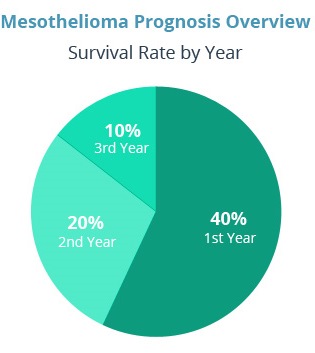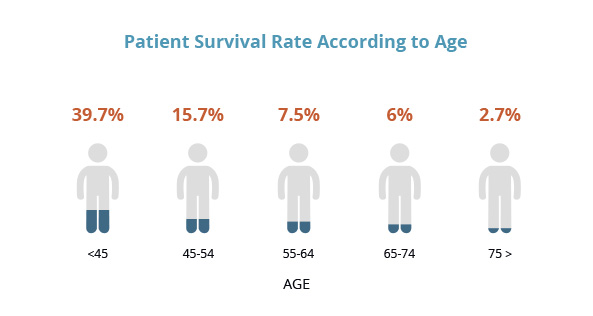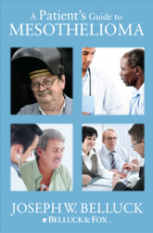Mesothelioma Prognosis
 Often called “asbestos cancer” due to its link to asbestos exposure, mesothelioma is highly aggressive and is resistant to many standard cancer treatments. Currently there are no known cures, and the average survival time varies from 4 – 18 months after diagnosis.
Often called “asbestos cancer” due to its link to asbestos exposure, mesothelioma is highly aggressive and is resistant to many standard cancer treatments. Currently there are no known cures, and the average survival time varies from 4 – 18 months after diagnosis.
The overall prognosis for patients is not very good. The disease has among the lowest five year survivability rates among different cancers and remains extraordinarily difficult to treat. While research is ongoing and our knowledge of the disease is definitely increasing faster than it ever has, doctors know an actual cure is still years away. However, large variabilities exist in many patients and there are people who have lived full lives after their diagnoses.
Mesothelioma Statistics
The prognosis figures are discouraging when examined from a purely statistical standpoint. Pleural mesothelioma typically presents in an advanced stage of progression with a ten-to-fourteen month lifespan expectation from diagnosis. Peritoneal mesothelioma often presents with a slightly more optimistic lifespan expectation and patients surviving two to five years are not uncommon. However, after five years, statistics show survivability dropping to well below thirty percent.

Statistics, however, do not tell the whole story. There are a variety of factors in the development of a patient’s prognosis and subtle differences among these factors can have a dramatic impact on the course the disease will take. The statistical models used often miss the extraordinary differences between a person’s stated prognosis/diagnosis and the way in which the disease actually impacts his or her life. While rare, it is not unknown for an individual to live for ten or sometimes even twenty years after a diagnosis.
Biology of the Disease
The most important disease-specific prognostic factors for patients involve the form of mesothelioma as presented and the histological subtype of the presented disease. Of the two major forms of mesothelioma, pleural generally presents with a worse prognosis than peritoneal does. The physiological reasons for this difference are not completely understood, but a major factor is the histological aspect of the cancer. Pleural presents about fifty percent of the time with an epitheloid histologic subtype, twenty percent of the time with sarcomatoid subtype and the remaining thirty percent is the biphasic subtype, which is a combination of the previous two subtypes. Peritoneal presents in the vast majority of diagnoses with the epitheloid subtype. This is significant because the epitheloid subtype responds more favorably to treatment than sarcomatoid or biphasic does. Thus, with the majority of peritoneal cases featuring the most treatable histological subtype, one would expect for it to have a better overall prognosis. Conversely, with only half of pleural cases involving the most treatable subtype, one would also expect a generally worse prognosis.
Patient Status
Along with the biological aspects of mesothelioma as presented, another set of important prognostic factors includes the stage of the disease at diagnosis, the health of the patient and his or her age. All three will have a major impact on life expectancy and the future course of the disease.
Stage of the Disease
The stage of disease at diagnosis is a crucial factor in the development of the patient’s prognosis. As with all forms of cancer, early detection is important, but this is especially true of mesothelioma. Because the cancer generally resists curative treatment, doctors can manage the disease more efficiently if they have caught it in its early stages. The diffuse nature of the disorder means advanced tumor progression will invade large areas of tissue, making treatment even more difficult. This cancer presents with symptoms shared by a number of other diseases and often goes undiagnosed because of these similarities. An early diagnosis is absolutely crucial if one hopes to control the disease.
Performance Status
Another important prognostic factor is the overall health of the person, with the patient’s age an important sub-factor in this determination. Generally, the healthier a patient presents, the better he or she will respond to cancer treatments and the better chances he or she has of longer survival. When grading a patient’s health, doctors develop a figure known as a patient’s “performance status.” There are a number of competing scales used to gauge this, but the scale sponsored by the World Health Organization goes from 0 to 5, with 1 and 4 being the general limits of description.
| Number | Description |
|---|---|
| 0 | Asymptomatic |
| 1 | Symptomatic but completely ambulant |
| 2 | Symptomatic, |
| 3 | Symptomatic, >50% in bed, but not bedbound |
| 4 | Bedbound |
| 5 | Death |
Performance status is revisited at multiple times during the course of treatment. It is initially developed after diagnosis and is then updated in response to the patient’s reaction to the treatment regimen he or she is a part of.
Exceptions to the Statistics
As we said above, the statistical prognosis is generally not in the patient’s favor. Seen only as a set of numbers, many people are understandably disheartened when they learn about their diagnosis. However, notable exceptions to these statistics do exist. Among the most famous of these exceptions was Dr. Stephen J. Gould of Harvard University. Dr. Gould was an internationally respected paleontologist and evolutionary biologist who conducted important research in both of these fields. Dr. Gould was diagnosed with peritoneal mesothelioma in 1982. After an initial period of depression, motivated by all of the negative statistics he read regarding his diagnosis, he became determined to not let the statistics regarding life expectancy rob him of all hope. When he died in 2002, it was from another form of totally unrelated cancer. Dr. Gould has written about his experience and his determination to not let simple statistics dictate his reaction to his diagnosis in the essay, “The Median Isn’t the Message.” We recommend Dr. Gould’s essay for everyone who has been diagnosed with this disease, or with any other form of cancer.
Dr. Gould’s experience certainly may not be standard, but his hopeful approach to his disease cannot be discounted.
Conclusion
As you can see, there are a number of factors that can impact the determination of a prognosis. The biologic facts of the disease as presented and the individual characteristics of the patient are all important co-factors and have serious implications for overall prognosis. Along with these factors, improving treatment regimens are another major element in one’s prognosis. There is still no cure for mesothelioma, but the treatments are improving, as is our knowledge of the actual mechanisms of the disease itself. Doctors are hopeful that we can translate our growing knowledge of the disease into more effective treatments and, therefore, better prognoses for patients.


